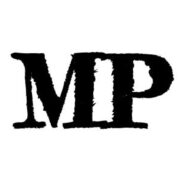
Image courtesy of Valerius Gallery
Fresh off his show at Valerius Gallery in Luxembourg Martin Paaskesen checks in with Erik Sommer to talk about being an actor, hip hop lyrics, the sculptural identity of canvas, and the vibrant state of painting.
The process is the only thing there is.
(ES) Describe your work for us.
(MP) My work is some kind of naive playful expression balancing between abstraction and figuration. It is mostly just fantasy and ideas. At least that is what I strive for. To me it is freedom.
Tell us a bit about your background. Where did you grow up?
I grew up on the west side of Aarhus, Denmark. It is the second largest city in the country. My father was a machine operator / engineer and had a small two-person metal work business and my mom was a nurse before she started working in the company. The west side of Aarhus is the rather tough part of town so I had to learn my way around in this environment.
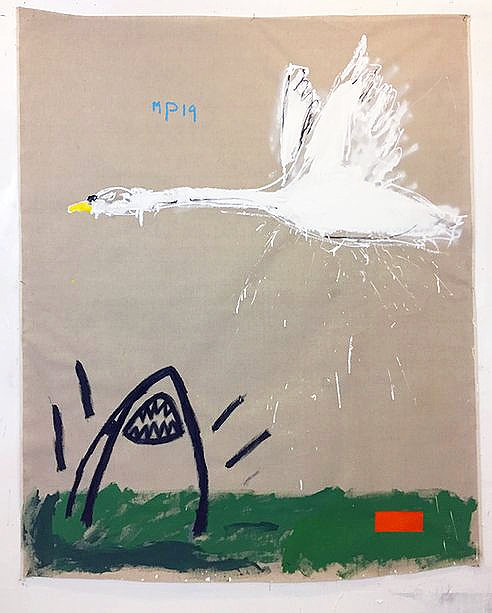
Image courtesy of Valerius Gallery
Besides my mom and dad always playing a lot of music I do not come from a very creative home. But still I was very attracted to being ‘seen’ creatively. Like, when I was a young teen I started becoming a part of the underground hip hop environment and I always envied the performers on stage for the courage and the energy outlet they must have felt. So I really wanted to be a rapper for many years while in school and also while working shitty jobs. I started writing lyrics which must have been my first real creative outlet. I never showed it to anybody though.
I actually never stopped writing lyrics. When I come up with a good line or something I put it in my notes. I do not have any intention of doing anything with it but it is a nice place to go when I am struggling with painting.
After I graduated Gymnasium (kinda like college) I had no clue what to do. I went from job to job and got along for about 4-5 years before I decided to become an actor. Long story short, I had seen this movie called ‘Pusher’ by Nicolas Winding Refn about 40 times and loved it, especially because of the two main characters and how they flowed with each other and really played their parts so lifelike and true. So I found an acting teacher and afterwards I applied for this very renowned acting school in Denmark and got in. I spent 4 years there and it was actually because of research for a role as a painter I coincidently found my love for painting.
Where do you live and work now?
I live and work in Copenhagen, Denmark.
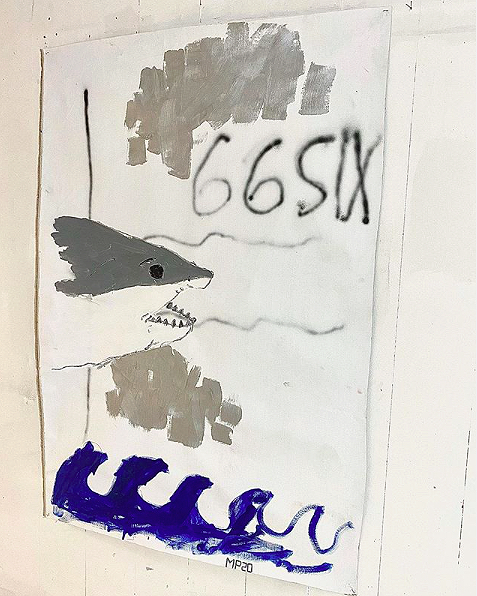
Image courtesy of the artist
How do you think this has influenced your work?
I think that my approach to art and the artworld in general is very unpretentious and I am very focused on having fun while I do what I do. I think that when art is made you have to approach it with a certain playfulness and just take it for what it is, while you make it. Then you can put all the springels and deep thoughts on top of it afterwards. This approach to me is being real to myself and what I do.
This comes from the hip hop environment and the codes there, but all the playfulness, the physicality and the courage to let go comes from acting. In the acting school I learned to be aware of myself and everybody/everything around me. I learned to be aware of the relation to things and people in a room. I use this in my work directly with the canvas but also when I build up a painting. A composition consists of relations between objects, elements, colours, mediums, tactility, etc.
Do you remember any artists as a child that captured your attention?
Mostly 60’s musicians and west side rappers.
I do remember in the 7th grade we went on a field trip to see a huge Paul McCarthy show in the ARoS Museum of Modern Art and that hit me. At this age I was not very cooperative with the idea of going to a museum as I thought at that time these places were the most boring places in the world. But this show mesmerized me and I was disgusted and drawn to it at the same time. It was so weird and crazy, and sexual and grotesque. It totally changed my mind and showed me that art can be whatever you feel like. This is a mindset I carry with me still.
Any artists today you are looking at?
Oh, so many. I often go back to find inspiration in some of the masters, but as Instagram has become so influential in the artworld it is a great place for me to get inspired. I have found out that these small unspoken organic communities form and you become a part of a group of artists that kinda talk the same language as you. And these artists inspire me a lot.
To mention some, I can say that I feel a connection to all of the Deli Grocery’s ‘Supper’-show artists. But also a lot of other artists. Almost everybody I follow on Instagram.
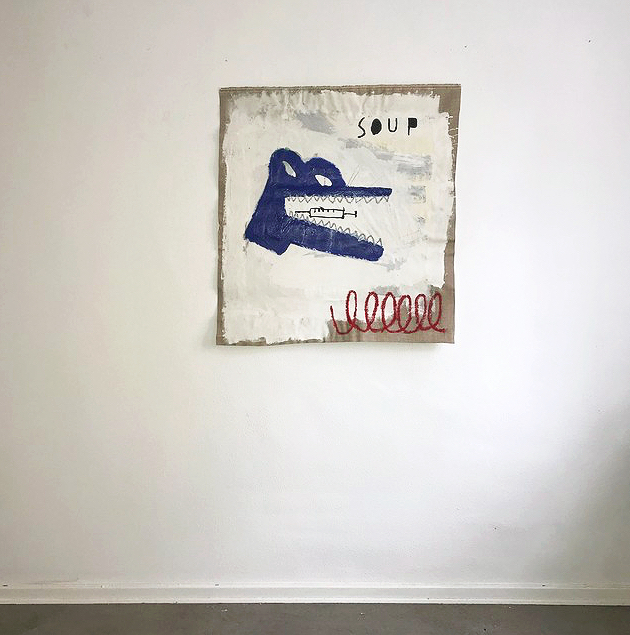
Image courtesy of Arte Nova Aarhus
You display your canvases unstretched directly on the wall. What do you like about this method?
It makes the canvas more tactile and I can feel the fabric much better. I can grab it and toss it, hug it, wrap it, whatever I feel like. It gives me a sense of freedom and looseness. I can sometimes get a contrived and empty feeling with a pre-stretched white canvas that comes straight from the factory.
When I work with raw pieces of canvas it has a more sculptural identity which is already loaded before I start working with it. It gives me a better, and already interesting, starting point.
Your palette is immediately recognizable, and gives your work a raw and unfinished look. Have you always worked in a similar manner?
No. When I discovered painting I was very influenced by painters I thought were fantastic. Too influenced. But again I was not thinking of being a professional painter when I started. It was just a hobby I could not keep my hands from.
As I started to paint more and more and learn more and more about other painters and the artworld in general it was a natural step for me that I had to develop my own language. And I was lucky because at a point in 2017 one of my friends gave me some huge pieces of industrial canvas which had been used for curtains at a locomotive workshop in Copenhagen. I cut out a random size piece and slammed it on my wall. This discovery totally changed my way of painting.
The canvas had so much history with footprints and forklift marks. It was so cool. So instead of “just” doing a motif I started working with the canvas and tried to bring forward and enhance what was already there. This approach I have continued with since.
You recently created a large mural on the side of a building. Tell us about this project.
It was a project curated by Jens-Peter Brask, a big collector and curator from Denmark. It was a huge project where 7 artists each painted a piece on this grey concrete colossus of a building placed in Valby, Copenhagen. It is a pretty iconic building but also a very boring building so these paintings which are placed around the sides and the back makes it glow up.
It is the biggest piece I have ever done. At least 10×12 meters (33×40 ft). It is actually a piece I have done before on canvas that Brask wanted me to paint there. At first I was not very keen on that as I wanted a more original work, preferably free hand, but as I started working I found that it is a bit more complicated going up in this size. I was naive.
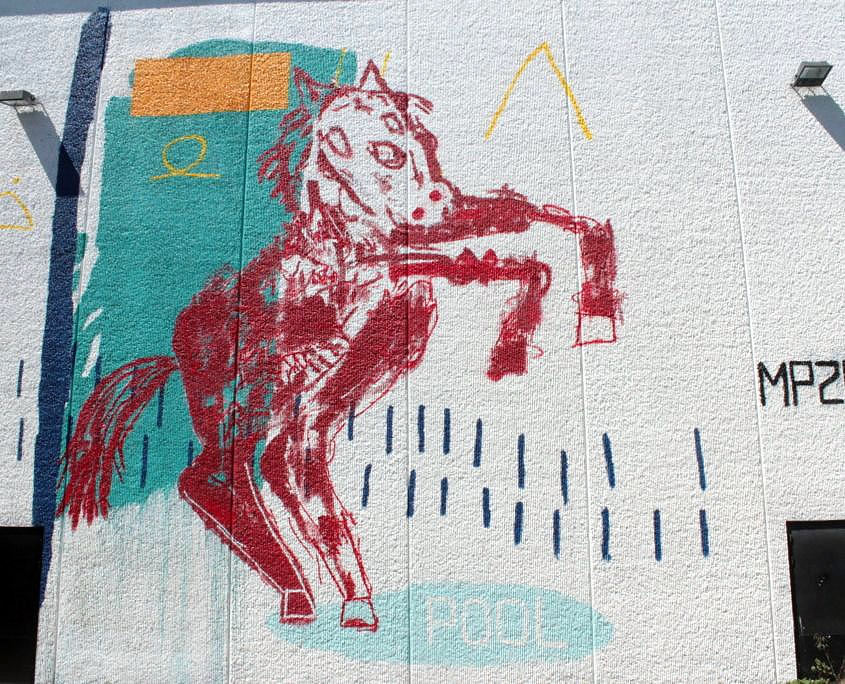
Image courtesy of Valby Lokaludvalg
What is your normal studio practice like? Any routines or superstitions?
Not really, no. I am in my studio almost every day. After I got kids I have found out that I really like to work in the morning. My brain is fresh and sharp, so I normally come to the studio around 9am or so. I always put on music and make myself a cup of coffee.
I love when I have something I know I have to do on a piece, but when I do not have that I normally just start to wander around and look at my paintings with new eyes. I can often see things I could not see the day before.
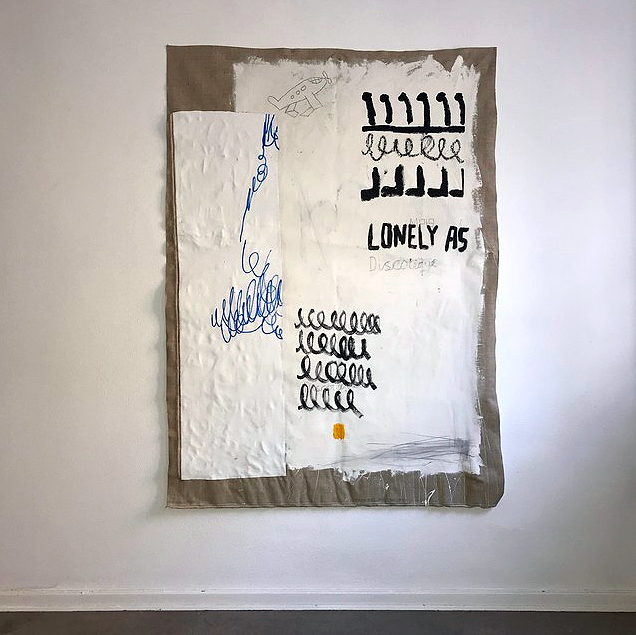
Image courtesy of Arte Nova Aarhus
What about your working technique? Walk us through how you start and then develop a piece.
I cut out a piece of canvas. Staple it to the wall. Sometimes I have a clear idea of where I want to go with a piece but often I start from scratch. I normally start to just look at it and try to visualize a colour and a medium I want to start with.
When I make my choice I put something on the canvas. This is totally up to the idea I get in the moment. It can be everything from a line, to a figure, a form, a box, etc. After I have put on my first element I look at it again and then I usually can see what would make sense to do next. And then it changes again. Every time I put on something the painting changes and sometimes it takes me somewhere where I never thought it would go. Even though it is a bit of a cliche to say it is a dance where I always have to see what the next thing that happens is and out of that make a new decision. Sometimes I try to visualize 3-4 steps ahead but I never come to that.
All this is the best thing in the world. It just makes so much sense to me to work like this.
Are you more concerned with the process or the end result?
The process is the only thing there is. The result is just the consequence of a process and its variable. It is out of your hands. As an artist who loves painting the result actually does not matter. The result is just where you can feed your ego if other people like what you do. Not saying that I don’t like that. I do. I love it when people praise what I do. I am too vain not to do that. But what I am trying to say is that this is not where my drive comes from.
Also if you wanna go down a holistic road, a result does not exist – for example, when I finish a painting and have a so-called result I look at it and see what I see and feel what I feel. But this result changes when another pair of eyes looks at it. Perhaps they see and feel something totally different. Then how can it be a result?
A result is absolute but an artwork is not.
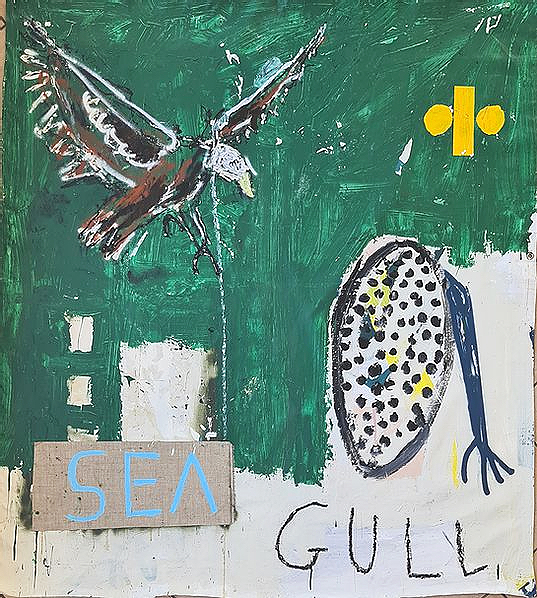
Image courtesy of Valerius Gallery
What current themes do you see in today’s art world?
I see liberty and unpretentiousness. I feel there is a tendency that artists do not worry so much. It has allowed us to do whatever you want. A carelessness.
This is manifested in paintings that are “easy” done. It is vibrant. I love this.
I think that painting is so much alive these days. I feel that this is one of the positive influences that Instagram has had on today’s art world. It is fast and it is bold. Perhaps you could call it some kind of New Neo-Expressionism or something. IG Expressionism.
About themes, I see animals/creatures and also something I would call concrete abstraction, which of course is a paradox but I see some concrete things being used in a abstract way which makes my mind question if the concrete things actually are to be taken for what they are or just for what they look like on a canvas as a compositional element.
What excites you the most about the current art world?
My hope and dream of becoming a bigger part of it.
Finally, what is your favorite color?
Skin color, and dark army green.
To see more of Martin Paaskesen’s work visit his Instagram page.
